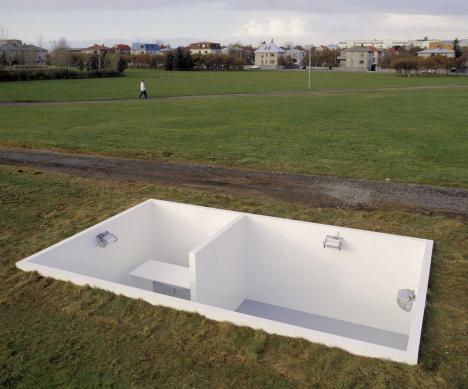
WHEN ART MIXES PLACES
The artists Michael Elmgreen and Ingar Dragset planned their work Powerless Structures, Fig. 11, for Louisiana’s Panorama Room in the South Wing. The work consists partly of the view from the Panorama Room that was already there: the sea, a few trees outermost in the visual field and the sky. And it also consists of an object that the artists have placed in the room: a white diving board, ready to use – and then again not. The big difference between the diving boards you see on holiday or at a swimming pool and this one is that the diving board is placed in a room at the Louisiana Museum. The view is real enough, but in the middle of the diving board, the thick pane of glass puts a stop to any further fantasies of jumping out into the blue. It is also a little too far to the water and a little too far down.
As in many of their works, Elmgreen & Dragset’s piece in Louisiana is based on a familiar object. But the meaning of the diving board has changed – partly because it has been placed somewhere else than where we expect to see it and partly because it has been deprived of its function.
The institution as a playground
What is a diving board then doing at the museum? What stories does it create here, where it has lost its function? Physically, it breaks through the museum walls, so it draws us out of the museum room – at least in our thoughts.
A large part of Elmgreen & Dragset’s works have museum space as their starting point. Often the concept of the “white cube” is the focal point. For example, in 1997 they held a performance (12 Hours of White Paint / Powerless Structures, Fig. 15, 1997) in which they painted layers of white paint on the already white walls of a gallery for twelve hours. After each layer, they washed the wall and painted it again with another layer of white paint – an absurd action, apparently. By continuing to paint and wash, they showed that the walls do not simply become white unless someone decides that they should be and paints them. The white room in the gallery is a result of a decision and an action and is therefore not simply neutral. They have also played with the gallery space in other works, for example by exhibiting a white room that was dug halfway down into the ground – a dysfunctional gallery room.
In a project from 2012, Elmgreen & Dragset worked again with the white cube when they collected, or “rescued”, pieces of white walls from various modern museums in Denmark, Germany, France, Switzerland, the US and England, including Louisiana. With an advanced technique, they removed a layer of white paint from an exhibition room and later exhibited the samples from the various “white cubes” side by side.
Elmgreen & Dragset’s works often deal directly with museum space and the institution. But they also concern how people generally read the world and act in it. What do we expect, and does everything always need to be as we expect and are used to?
FILM
FACTS
Michael Elmgreen (1961, DK) and Ingar Dragset (1968, NO) have worked together since 1995. They were also a couple privately for many years. Since 1997, Berlin has been their base, and they still work there, although Elmgreen now lives in London.
At first, Elmgreen & Dragset worked with performances. Dragset had a background in theater, but together they shifted quickly towards installation art.
Powerless Structures is a general title that they have used for a large number of works. These works all draw upon something familiar that they turn upside down by breaking with the object’s normal function, making it alien to us. The work at Louisiana, Powerless Structures, Fig. 11, was created specifically for the site where it is located today in connection with the exhibition New Art from Denmark and Scania in 1997. The work was away from the site for a few years before it was purchased by the museum and returned to its spot permanently.
Other works by Elmgreen & Dragset in Louisiana’s collection: When a Country Falls in Love with Itself, 2008, and Uncollected (Baggage Reclaim), 2005.
ACTIVITIES
How would a different placement of the diving board have affected your reading of the work? If the diving board had been installed at a school, for example? At a swimming pool? In a bank? Or in a hospital?
Find an object that is typical of a museum. Consider where you would move it to create a new meaning. Also consider whether you want to make a comment on the museum or on the new location to which you want to move the “museum object”.
Many objects are so firmly attached to a location that they almost seem identical with it and almost absurd when they appear elsewhere.
Create new meanings by taking objects that are very specific to certain locations and placing them somewhere else. What meanings arise? What does it do to our perception of the object and the place where it is located?
For example, take clippings from magazines – home magazines, women’s magazines, weekly journals or the like, or take photos.
Interdisciplinary project, with film, drama and Danish:
Use the diving board as the starting point for a story. It can be a film, a play, a short story or a poem. Think of the diving board as a symbol or metaphor – what meanings does it give to your story? Find a title that focuses on the object, for example, “The Diving Board”, “A Diving Board”, or “On the Diving Board”, and consider what meaning it will have for your story.












